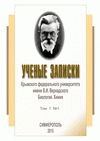Novosibirskiy nacional'nyy issledovatel'skiy gosudarstvennyy universitet
he human body is closely connected to the microflora through thousands of biologically active low molecular weight compounds. In the last decade, the idea has spread that in order to maintain and restore the microecology of the human body, not only live bacteria should be used, but also products of bacterial lysis and filtered products of their metabolism. Such low molecular weight microbial components are called metabiotics. According to their functional characteristics, metabiotics can be divided into the following large groups: 1) active metabolites (branched and unbranched short-chain fatty acids, including butyrate, acetate, propionate; nitric oxide, methane, vitamins, nucleotides, amino acids, peptides, etc.); 2) structural components (muramyldipeptide, S-proteins, peptidoglycans, lipoteichoic acids, lipopolysaccharides (LPS), lectins, phospholipids, nucleic acids, etc.); 3) neuromodulators (serotonin, glycine, dopamine, norepinephrine, acetylcholine, tryptamine, etc.).; 4) substances with antibacterial activity (lysozyme, bacteriocins, biosurfactans, polyamines, lectins, etc.); 5) antioxidants (peptides, polysaccharides, glutathione, butyric acid, vitamin B12, thiamine, etc.). In the human body, metabiotics act as an energy substrate for the intestinal normoflora and enterocytes; signaling molecules for enterocytes and the lymphoid-associated immune system of the intestinal wall, «immune simulators», inhibit the development of pathogenic microbiota and yeast flora, participate in the modulation of metabolic processes of both the microbiota itself and the body as a whole, have neuromodulating, antioxidant antibacterial action, they are one of the most powerful biological agents that support the growth and development of beneficial bacteria. This allows us to consider metabiotics as a promising group of drugs for the correction of dysbiotic and systemic metabolic disorders in adults and children. At the present stage of the development of biotic medicine, an idea has been formed about targeted metabiotics in which bacterial lysates are enriched with extracts of medicinal plants. Preparations based on metabiotics and phytoextracts (phytolysates) have already proven themselves to be effective means for normalizing the gastrointestinal tract in children and adults, restoring normal intestinal microflora, preventing the development of respiratory infections, supporting the function of the cardiovascular and urinary systems, correcting adverse events against the background of chemotherapy, in the treatment of gerontological patients, etc. Clinical studies on the use of phytolysates to maintain the intestinal microbiota against the background of chemo and radiation therapy in cancer patients in order to reduce the negative effects of antitumor therapy seem promising.
metabiotics, bacterial lysates, ultralysates, phytoextracts, extracts of medicinal plants, microflora, microbiota
1. Rani L. Unravelling the role of gut microbiota in Parkinson’s disease progression: Pathogenic and therapeutic implications / L. Rani, A. C. Mondal // Neuroscience Research. – 2021. – No 168. – P. 100–112.
2. Rooks M. G. Gut microbiota, metabolites and host immunity / M. G. Rooks, W. S. Garrett // Nature Reviews Immunology. – 2016. – Vol. 16, No 6. – P. 341–352.
3. Cryan J. F. The microbiota-gut-brain axis / J. F. Cryan, K. J. O’Riordan, C. S. M. Cowan [et al.] // Physiological Reviews. – 2019. – No 99. – 1877–2013.
4. Wang Z. Dysbiosis of oral and gut microbiota and its association with metabolites in patients with different degrees of coronary artery stenosis / Z. Wang, L. Li, C. Wang [et al.] // Chinese Medicine
5. Luangphiphat W. Exploring of gut microbiota features in dyslipidemia and chronic coronary syndrome patients undergoing coronary angiography / W. Luangphiphat, P. Prombutara, V. Muangsillapasart [et al.]
6. Kruglyy stol «Metabiotiki: novaya ideya ili estestvennoe razvitie probioticheskoy koncepcii» [elektronnyy resurs]
7. Pacenko M. B. Znachenie i sovremennye vozmozhnosti pre- i metabiotikov v lechenii simptomaticheskoy neoslozhnennoy divertikulyarnoy bolezni obodochnoy kishki / M. B. Pacenko,
8. den Besten G. The role of short-chain fatty acids in the interplay between diet, gut microbiota, and host energy metabolism/G. den Besten, K. van Eunen, A. K.Groen [et al.] // Journal of Lipid Research.–2013.
9. Schwiertz A. Microbiota and SCFA in lean and overweight healthy subjects / A. Schwiertz, D. Taras, K. Schdfer [et al.] // Obesity. – 2010. – No 18. – P. 190–195.
10. Fernbndez J. Traditional processed meat products re-designed towards inulin-rich functional foods reduce polyps in two colorectal cancer animal models / J. Fernbndez, E. Ledesma, J. Monte [et al.] // Scientific
11. Moffett J. R. Acetate revisited: a key biomolecule at the nexus of metabolism, epigenetics and oncogenesis – Part 1: Acetyl-CoA, Acetogenesis and Acyl-CoA short-chain synthetases / J. R. Moffett,
12. Rnos-Covibn D. Intestinal short chain fatty acids and their link with diet and human health / D. Rnos-Covibn, P. Ruas-Madiedo, A. Margolles [et al.] // The Frontiers in Microbiology. – 2016. – No 7. – P. 185.
13. Hong Y. H. Acetate and propionate short chain fatty acids stimulate adipogenesis via GPCR43 / Y. H. Hong, Y. Nishimura, D. Hishikawa [et al.] // Endocrinology. – 2005. – No 146. – P. 5092–5099.
14. Louis P. Diversity, metabolism and microbial ecology of butyrate-producing bacteria from the human large intestine / P. Louis, H. J. Flint // The Fems Microbiology Letters. – 2009. – No 294. – P. 1–8.
15. Treptow-van L. S. The carbohydrate crystalean and colonic microflora modulate expression of glutathione S-transferase subunits in colon of rats / L. S. Treptow-van, G. Rechkemmer, I. Rowland [et
16. de Vadder F. Gut-brain signaling in energy homeostasis: the unexpected role of microbiota-derived succinate / F. de Vadder, G. Mithieux // The Journal of Endocrinology. – 2018. – Vol. 236, No 2.
17. Ploskireva A. A. Patogeneticheskaya terapiya narusheniy mikrobiocenoza zheludochno-kishechnogo trakta pri ostryh kishechnyh infekciyah u detey / A. A. Ploskireva // Pediatriya. Prilozhenie k
18. Tohirien B. Biotehnologicheskaya programma v forme BAD dlya podderzhki indigennoy mikroflory kishechnika / B. Tohirien, A. A. Vekovcev, O. N. Bulashko [i dr.] // Vestnik Yuzhno-Ural'skogo
19. Wan Z. Intermediate role of gut microbiota in vitamin B nutrition and its influences on human health / Z. Wan, J. Zheng, Z. Zhu [et al.] // Frontiers in Nutrition. – 2022. – No 9. – P. 1031502.
20. Daisley B. A. Emerging connections between gut microbiome bioenergetics and chronic metabolic diseases / B. A. Daisley, D. Koenig, K. Engelbrecht [et al.] // Cell Reports. – 2021. – No 37. – P. 110087.
21. Magn'sduttir S.Systematic genome assessment of B-Vitamin biosynthesis suggests co-operation among gut microbes/S. Magn'sduttir, D. Ravcheev, V. de Crycy-Lagard [et al.]//Frontiers in Genetics.– 2015.– No6.
22. Bosco G. Proprieta immunologiche e immunochimiche di lisati batterici ottenuti con ultrasuoni [Immunological and immunochemical properties of bacterial lysates obtained by ultrasonic waves]
23. Duchon L. L'extrkme sensibility des phagocytes aux toxines microbiennes, aux toxines antibiotiques, aux lysats microbiens [The extreme sensitivity of phagocytes to bacterial and antibiotic toxins and to bacterial
24. Drake C. H. Letter: Salivary antibody response to oral vaccine / C. H. Drake, J. E. Smith // Lancet. – 1975. – Vol. 27, No 2(7935). – P. 614–615.
25. Janeway C. A. Jr. Approaching the asymptote? Evolution and revolution in immunology / C. A. Jr. Janeway // Cold Spring Harbor symposia on quantitative biology. – 1989. – Vol. 54, No 1. – P. 1–13.
26. Zaplatnikov A. L. Bakterial'nye lizaty: tradicionnye predstavleniya i novaya paradigma / A. L. Zaplatnikov, A. A. Girina, V. I. Svincickaya [i dr.] // Russkiy medicinskiy zhurnal. Mat' i ditya.
27. Braido F. Bacterial lysate in the prevention of acute exacerbation of COPD and in respiratory recurrent infections / F. Braido, F. Tarantini, V. Ghiglione [et al.] // International Journal of Chronic Obstructive
28. Polovinkina V. S. Immunoad'yuvantnye svoystva muramildipeptida / V. S. Polovinkina, E. Yu. Markov // Acta Biomedica Scientifica. – 2012. – № 1. – S. 149–153.
29. Kearney S. C. Immunoregulatory and immunostimulatory responses of bacterial lysates in respiratory infections and asthma / S. C. Kearney, M. Dziekiewicz, W. Feleszko // Annals of allergy, asthma
30. Van Avondt K. Bacterial immune evasion through manipulation of host inhibitory immune signaling / K. Van Avondt, N. M. van Sorge, L. Meyaard // PLoS Pathogens. – 2015. – Vol. 11, No 3.– P. e1004644.
31. Mansurova A. S. Rol' probiotikov v korrekcii nezhelatel'nyh yavleniy na fone himioterapii u pacientok so zlokachestvennymi novoobrazovaniyami yaichnikov / A. S. Mansurova, V. E. Voycickiy,
32. Kalyuzhin O. V. Fenomen trenirovannogo immuniteta i mehanizmy deystviya nespecificheskih immunomodulyatorov / O. V. Kalyuzhin//Rossiyskiy allergologicheskiy zhurnal.– 2015. – № 4.–S.45–51.
33. Fang L. OM-85 Broncho-Vaxom®, a bacterial lysate, reduces SARS-CoV-2 binding proteins on human bronchial epithelial cells / L. Fang, L. Zhou, M. Tamm [et al.] //Biomedicines. – 2021.– Vol. 9, No 11. – P. 1544.
34. Pivniouk V. The OM-85 bacterial lysate inhibits SARS-CoV-2 infection of epithelial cells by downregulating SARS-CoV-2 receptor expression / V. Pivniouk, O. Pivniouk, A. DeVries [et al.] // The
35. Shenderov B. A. Metabiotiki – novaya tehnologiya profilaktiki i lecheniya zabolevaniy, svyazannyh s mikroekologicheskimi narusheniyami v organizme cheloveka / B. A. Shenderov
36. Reuben R. C. Bacteriocins: potentials and prospects in health and agrifood systems / R. C. Reuben, C. Torres // Archives of Microbiology. – 2024. – Vol. 206, No 5. – P. 233.
37. Hou K. Microbiota in health and diseases / K. Hou, Z-X. Wu, X-Y. Chen [et al.] // Signal Transduction and Targeted Therapy. – 2022. – No 7. – P. 135.
38. Puls J-S. Staphylococcus epidermidis bacteriocin A37 kills natural competitors with a unique mechanism of action / J-S. Puls, B. Winnerling, J. J. Power [et al.] // The ISME Journal. – 2024. – Vol. 18, No 1. – P. 044.
39. Heilbronner S. The microbiome-shaping roles of bacteriocins / S. Heilbronner, B. Krismer, H. Brctz-Oesterhelt [et al.] // Nature Reviews Microbiology. – 2021. – No 19. – P. 726–739.
40. Cuervo L. Low-molecular-weight compounds produced by the intestinal microbiota and cardiovascular disease / L. Cuervo, P. L. McAlpine, C. Olano [et al.] // International Journal of Molecular Sciences. – 2024.
41. Shpagina L. A. Rol' mul'tisinbiotika v kompleksnom lechenii gerontologicheskih pacientov / L. A. Shpagina, O. N. Gerasimenko, A. M. Gorobey [i dr.] //Sibirskiy medicinskiy vestnik.–2020.–№ 3.
42. Jang H. J. A narrative review on the advance of probiotics to metabiotics / H. J. Jang, N. K. Lee, H. D. Paik // Journal of Microbiology & Biotechnology. – 2024. – Vol. 34, No 3. – P. 487–494.





